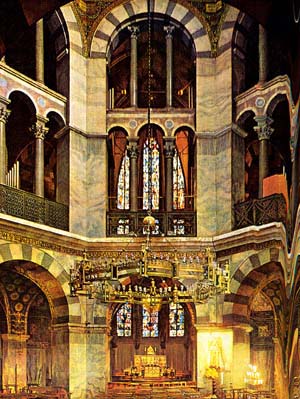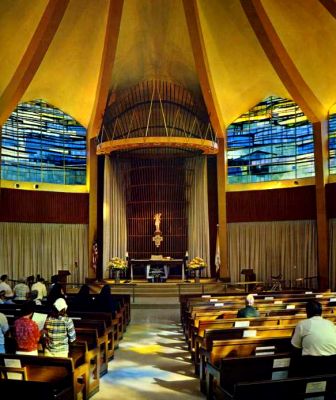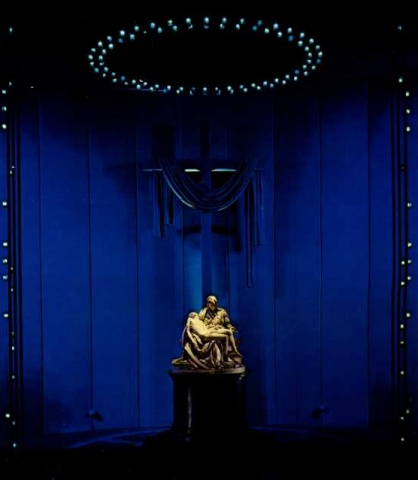"Lepanto, 2001 (Panel 2 of 12)" Cy Twombly
Pope St. Pius V was pope for only six years, but he accomplished a great deal. Perhaps Pius's most amazing achievement was helping to bring about the decisive defeat of the Ottoman Empire, which after decades of victorious advance appeared to be on the verge of overrunning Christian Europe. In order to obtain this victory, Pius proceeded energetically on many fronts. He exhorted the faithful to pray and give alms, and led the people of Rome in vigils, processions, and recitation of the rosary, while channeling all available funds towards Europe's defense. So that the Ottoman threat might be met in a coordinated and powerful way, Pius persuaded most of the major Catholic maritime states of the Mediterranean (though not France, Portugal, or the Holy Roman Empire) to unite as "The Holy League." Even this combined force was outnumbered as they assembled to face the Ottoman fleet off Greece. The Ottomans had already seized Cyprus, where less than two months earlier, a Venetian force had surrendered after being promised safe conduct by the Ottoman commander, Lala Kara Mustafa Pasha. However, Mustafa Pasha broke his promise, and not only imprisoned the Venetian sailors, but had the admiral of the Venetian force flayed alive, afterwards displaying the skinned body from his galley. Mustafa Pasha also ordered the execution of the admiral's top commanders, adding their heads to the display of gruesome trophies on his galley.
These atrocities were well known in the Christian fleet, and must have hardened the resolve of its officers and sailors as they maneuvered for battle. When battle was imminent, Don John of Austria, the 24 year old commander of the fleet, unchained the criminals who rowed the galleys, issued them weapons, and promised that if they fought well they would receive their freedom. Pius V had already granted every man in the fleet a plenary indulgence, and that evening every man in the fleet prayed the rosary. On the following day, thanks to fair winds, revolutionary tactics, advanced weapons, and ferocious fighting, the fleet of the Holy League destroyed or captured all but thirteen ships of the Ottoman fleet. 30,000 Ottomans had been killed, including Mustafa Pasha. Not until the Great War would Europe again witness such carnage.
News from the fleet would not reach Rome for days, but Pius learned of the victory as soon as it happened. At the time of the battle, Pius was meeting with his cardinals at the Dominican Basilica of Santa Sabina on the Aventine Hill. In the midst of this conference Pius paused to gaze out the window. There in the sky the Blessed Mother favored him with a vision of the victory. Turning to his cardinals Pius said, "Let us set aside our business and fall on our knees in thanksgiving to God, for he has given our fleet a great victory." The victory decisively checked the Ottoman Empire's expansion.
Miguel Cervantes, who would later write Don Quixote, fought courageously at Lepanto, suffering three wounds, one of which cost him the use of his left hand. Cervantes called the battle “the highest and most memorable occasion that past and future centuries will ever hope to see”.
These atrocities were well known in the Christian fleet, and must have hardened the resolve of its officers and sailors as they maneuvered for battle. When battle was imminent, Don John of Austria, the 24 year old commander of the fleet, unchained the criminals who rowed the galleys, issued them weapons, and promised that if they fought well they would receive their freedom. Pius V had already granted every man in the fleet a plenary indulgence, and that evening every man in the fleet prayed the rosary. On the following day, thanks to fair winds, revolutionary tactics, advanced weapons, and ferocious fighting, the fleet of the Holy League destroyed or captured all but thirteen ships of the Ottoman fleet. 30,000 Ottomans had been killed, including Mustafa Pasha. Not until the Great War would Europe again witness such carnage.
News from the fleet would not reach Rome for days, but Pius learned of the victory as soon as it happened. At the time of the battle, Pius was meeting with his cardinals at the Dominican Basilica of Santa Sabina on the Aventine Hill. In the midst of this conference Pius paused to gaze out the window. There in the sky the Blessed Mother favored him with a vision of the victory. Turning to his cardinals Pius said, "Let us set aside our business and fall on our knees in thanksgiving to God, for he has given our fleet a great victory." The victory decisively checked the Ottoman Empire's expansion.
Miguel Cervantes, who would later write Don Quixote, fought courageously at Lepanto, suffering three wounds, one of which cost him the use of his left hand. Cervantes called the battle “the highest and most memorable occasion that past and future centuries will ever hope to see”.















